The Rising Sun Redbud, scientifically known as Cercis Canadensis ‘JN2’, is a stunning variety of the spring-flowering tree renowned for its vibrant foliage and striking fuchsia-red blooms. As spring arrives, its leaves begin a mesmerizing transition from a deep apricot to gold, yellow, and eventually lime-green during the summer. This progression ensures a display of all four shades simultaneously for several weeks.
During the earliest days of spring, this redbud variety is adorned with brilliant fuchsia-red flowers, making it a sight to behold against its twisted dark reddish-brown winter bark.
It’s not just a seasonal marvel; its year-round appeal is evident as it grows 8 to 12 feet tall and spreads roughly 8 feet wide. This makes it a perfect standalone specimen on lawns, amidst other flowering plants, or along natural areas. As a variant of a native tree, it’s also fitting for natural plantings.

Notably, the Rising Sun Redbud is more heat and drought resistant than many of its counterparts. While it thrives in full sun, ensuring the most vibrant foliage colors, it also flourishes in partial shade. This versatile tree is hardy from zones 5 to 9, and can manage in zone 4 if sheltered. It’s adaptable to various soil types, except wet, poorly-drained soils, and boasts a robust growth rate. Additionally, it’s largely free from significant pests or diseases.
Characteristics that set it apart include:
- Multi-hued foliage ranging from orange to light green.
- Early spring blossoms in an eye-catching fuchsia-red.
- A neat, symmetrical shape.
- Enhanced heat and drought tolerance compared to other redbud varieties.
II. Appearance
While many are familiar with spring bloomers like cherries and crab apples, the equally magnificent redbud, a native tree, remains somewhat of a hidden gem. The redbud stands out early in spring, even before other trees shake off their winter slumber. Its fuchsia-red flowers dazzle on barren branches, reminiscent of vibrant tropical flora. This cold-hardy tree is versatile, thriving in sun or shade and in various soil types, making it a deserving choice for every garden.
However, its limited recognition might be because, post-blooming, its leaves, despite being appealing at 3-5 inches across with a heart-shaped base, render it just another green tree. This perception changed with the introduction of The Rising Sun Redbud, which extends the tree’s spectacle from a spring bloomer to a vibrant foliage showcase spanning three seasons.
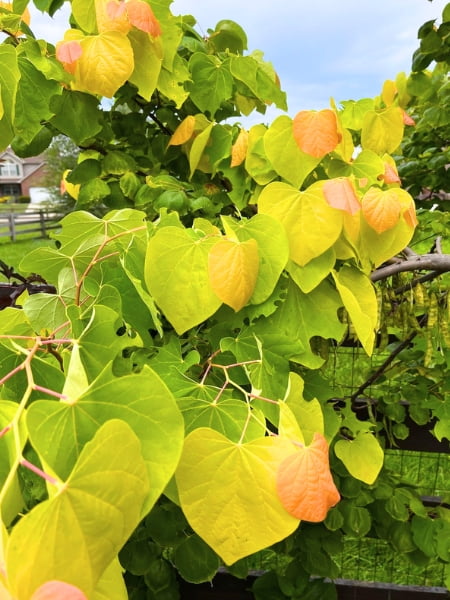
III. Growing and Care Conditions
The Rising Sun Redbud is not just any tree; it’s a constantly evolving tapestry of colors and beauty. While its early spring flowers are undeniably gorgeous, this tree’s splendor continues as its leaves emerge and change throughout the seasons. Starting with a deep apricot hue in its youthful state, the heart-shaped leaves transition to gold and then to yellow.
This continuous growth and color change mean that the tree often showcases all these hues simultaneously, painting a mesmerizing kaleidoscope. As summer approaches and growth stabilizes, the leaves settle into a luminous lime green. Upon closer inspection, one can observe the intricate speckling on the leaves, adding depth to its rich palette.
This vibrancy persists throughout summer and, come autumn, morphs into a light yellow, complementing the other foliage in its surroundings. Its beauty doesn’t stop there. During winter, the tree’s twisted branches with their deep red-brown bark, which darkens and furrows as it matures, stand as a testament to its year-round allure. Let’s delve deeper into the ideal conditions and care techniques that ensure this tree thrives.
Planting
When choosing a location for the Rising Sun Redbud, ensure there’s a 6 to 8-foot distance from existing structures and at least 3 feet from fences. Prepare the ground by clearing a 5-foot radius of potential competitors like weeds or other plants. When digging a hole for your redbud, it should be double the width of the root ball’s diameter and the same depth.
Gently massage the roots to release them. Place the tree in the hole, fill halfway with soil, then water. After the soil is settled, complete filling the hole and water again, using approximately 15 gallons in total.
To keep the soil’s moisture balanced and enhance nutrients, add a 3 to 4-inch layer of mulch around the tree, ensuring a 4-inch gap from the trunk to prevent potential fungal issues.
The Rising Sun Redbud is adaptable to a variety of soils, whether acidic or alkaline, loamy or clayey. The key requirement is well-draining soil. While it can thrive in less fertile soils, avoid overly wet areas. Elevate the planting on mounds or slopes if your garden tends to pool water. This robust tree demands little maintenance but watch for any plain green stems emerging from the ground and remove them promptly.
Position the redbud where it will receive a minimum of four hours of sunlight daily, allowing it to grow to its full potential width of 8 feet. After planting, ensure consistent watering to maintain soil moisture. An organic mulch layer can also aid in retaining the necessary moisture.
Light
This redbud variety is notable for its resilience and adaptability. Suitable for zones 5 to 9 and some sheltered areas in zone 4, it flourishes best in full sun for vibrant foliage. However, it can also thrive in partial shade. Notably, the Rising Sun Redbud demonstrates superior heat and drought resistance compared to many other varieties.
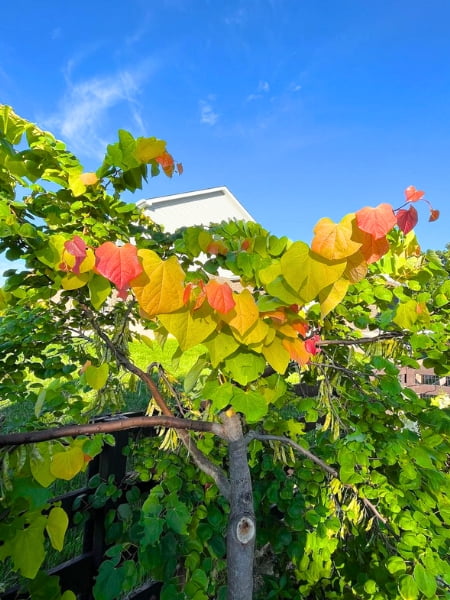
Watering
For the initial year, it’s vital to maintain moist soil without overwatering, preferably watering during cooler evening hours. After planting, deep water the tree twice weekly, reducing to once weekly as it becomes established.
Fertilizer
Come early spring, consider enriching the soil around your Rising Sun Redbud with compost or a 5-10-5 granular fertilizer, adhering to the product’s guidance for application. Despite its modest fertilizer needs, twice yearly applications typically suffice.
Pruning
For a Rising Sun Redbud, the optimal pruning time is late spring or early summer, shortly after its blooming period. Prioritize removing large lower branches, any that crisscross or create friction, and trim close to the trunk, avoiding leftover stubs. Given its naturally balanced growth pattern, there’s little need for extensive reshaping. Your primary focus should be on eliminating any branches that are dead, damaged, or diseased.
Pests and Diseases
To safeguard your tree from diseases and pests, the first line of defense is proper care—this includes correct positioning, appropriate watering, and timely fertilization. Borer insects can become an issue, especially if the tree sustains damage, including from garden tools.
Using mulch not only helps with moisture retention but also reduces weed growth, negating the need for lawn machinery close to the tree, which can inadvertently cause damage. Another pest to watch for is Scale, which can be managed using horticultural oil applied over the tree.
While the Rising Sun Redbud shares some weaknesses with the standard eastern redbud, such as cankers, it can also suffer from blight, leaf spots, mildew, and infestations from borers, beetles, and leafhoppers. However, a significant advantage is its resistance to deer.
Maintenance
Rising Sun Redbuds are notably low-maintenance. They are versatile in terms of light requirements, thriving in full sun to partial shade, and can adjust to various soil types, provided it’s well-draining. For the initial months after planting, water the tree deeply around twice a week.
Once established, it’s resilient to drought, though during prolonged dry spells, a weekly deep watering is beneficial. Surround the tree’s base with a 2-inch layer of mulch equivalent to the canopy’s size, ensuring it doesn’t touch the trunk to prevent disease and pests. During early spring or planting, a balanced, slow-release fertilizer can be applied for added vigor.
Though Rising Sun Redbuds don’t usually demand pruning, if it becomes necessary, undertake it just after the blooming phase to excise any undesired branches. Avoid winter pruning as it could lead to a reduction in blooms.
To maximize the potential of your Rising Sun Redbud, the key lies in its initial care and setup. Mulching is pivotal, not only for preserving soil moisture but also as it decomposes, it provides nutrients. Moreover, considering some redbuds may have a deep taproot, thorough watering is preferable over shallow, frequent watering to nourish the root adequately.
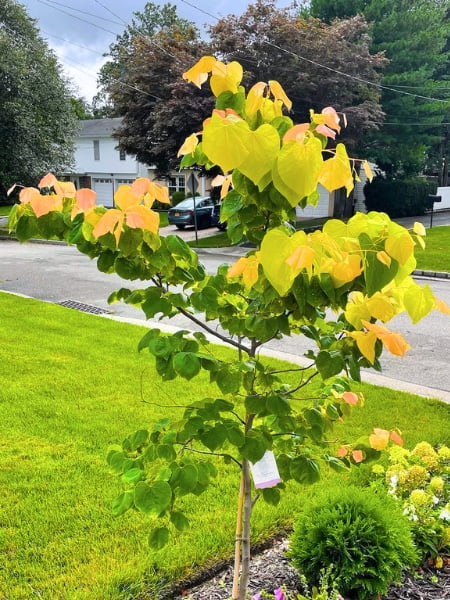
Uses
The Rising Sun Redbud is more than just a springtime spectacle. Envision this tree standing tall on your lawn or nestled among smaller shrubs, offering a dynamic visual experience from the first blooms of spring, continuing throughout summer, and into the vibrant hues of fall. Unlike trees that merely dazzle in spring, this redbud offers year-round interest.
Originating from wooded locales, the Eastern Redbud seamlessly blends into the periphery of natural garden spaces, bridging the vibrant garden flora and the serene backdrop of the woods. Including it in a mix of shrubs and trees crafts a mesmerizing collage of fluctuating colors and blooms, enriching your garden’s ambiance.
The versatility of the Rising Sun Redbud is noteworthy. Whether it’s accentuating a natural corner of your property, standing out as a central attraction in your yard, or even being highlighted with uplighting, its presence is always captivating. For color coordination, consider planting kaleidoscope abelia at its base for a golden-yellow contrast or pair it with junipers; their blue-green shades wonderfully complement the redbud’s fuchsia blooms.
Ultimately, wherever you decide to plant your Rising Sun Redbud, ensure it’s within sight. Its allure is bound to draw your gaze time and again.
Reasons to have this tree
Imagine a beacon of beauty and vibrancy in your garden, standing tall and radiant throughout the year. The Rising Sun Eastern Redbud, affectionately known as the Judas Tree, promises just that. Not only does it drench your landscape in fuchsia splendor every spring, but its green-gold foliage also casts a mesmerizing hue, embodying vitality like no other. It’s not merely a tree; it’s an experience, a transformative element that elevates the aesthetics of your outdoor space.
Distinguishing the Rising Sun from other redbuds is its unique and symmetrical profile. The meticulously stacked foliage offers a layered spectacle, resilient to the challenges of heat, drought, and cold. Moreover, it’s not just a treat for the eyes; this tree magnetically draws nature’s grace, inviting birds and butterflies, ensuring that your garden is always teeming with life and activity.
From a distance, the mix of golden and green leaves may deceive an observer into believing they’re witnessing a perpetual bloom. Large, heart-shaped leaves ornament its sturdy branches, layered so exquisitely that they seem almost purposefully arranged.
As the seasons progress, these leaves embark on a journey of color, beginning with golden yellow and transitioning through shades of peach, apricot, and ending in a brilliant orange come fall. It’s a perpetual dance of colors, ensuring your garden remains vibrant throughout.
Even before the break of dawn, the tree pre-empts the sun by flaunting its vibrant blooms. Every spring, the tree is adorned with waves of pea-like, fuchsia blooms, radiating an aroma reminiscent of orange blossoms. It’s not just a visual delight but an olfactory one, luring butterflies from far and wide.
Its multifaceted appearance, reminiscent of wind chimes on a breezy day or a leafy kaleidoscope, ensures it’s a conversation starter. Its moderate size means you can house multiple in a mid-sized garden, creating a cluster of beauty and vibrancy.
Yet, for all its grandeur, the Rising Sun Redbud is surprisingly low maintenance. It’s adaptable, enduring a range of temperatures and soil conditions. While its hardiness means it can weather dry spells, a generous layer of mulch around its base can further optimize its growth, ensuring the soil remains moist and enriched.
The Rising Sun Redbud doesn’t just grow; it thrives, adding a touch of maturity and sophistication to even the newest landscapes. Welcoming this tree into your garden isn’t just a horticultural choice; it’s a decision to embrace unparalleled beauty and resilience.
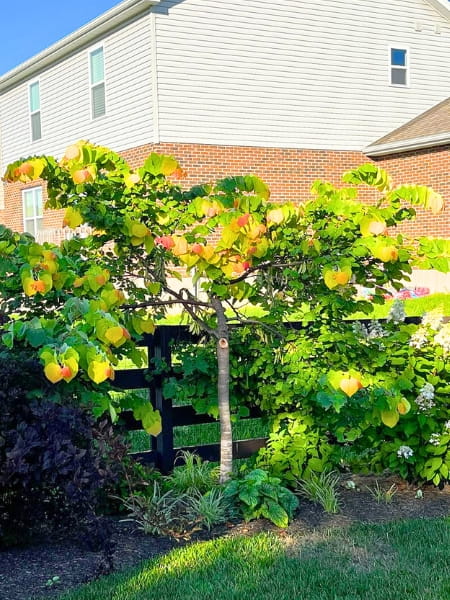
FAQs
What makes The Rising Sun Eastern Redbud different from other redbuds?
The Rising Sun Eastern Redbud is renowned for its vivid fuchsia blooms and vibrant green-gold foliage. Unique to this redbud is its symmetrical silhouette and dimensional stacked foliage that shines in all seasons, attracting wildlife such as birds and butterflies. Its leaves undergo a spectacular color transition from golden yellow to peach, and its heart-shaped leaves are layered in a way that is reminiscent of wind chimes or sequins.
How does the Rising Sun Redbud handle varying growing conditions?
Despite its beauty, the Rising Sun Redbud Tree is resilient and adaptive. It can handle a wide range of temperatures and soil conditions. It can withstand dry periods and requires minimal maintenance. For optimal growth, it’s recommended to mulch around the tree to help the soil retain moisture and enrich the organics of the soil.
When is the best time to plant the Rising Sun Redbud?
When planting your Rising Sun Redbud Tree, ensure the hole is about three times the size of the root ball. It’s beneficial to amend the soil with compost, especially in areas with heavy clay. The top of the root ball, where roots begin to separate, should be slightly above the ground level.
Are there any special considerations for pruning the Rising Sun Redbud?
While specific pruning details were not provided in the discussion, many redbuds, including the Rising Sun variant, typically don’t require excessive pruning. However, if needed, prune after the blooming season to maintain its shape and remove any dead or damaged branches.
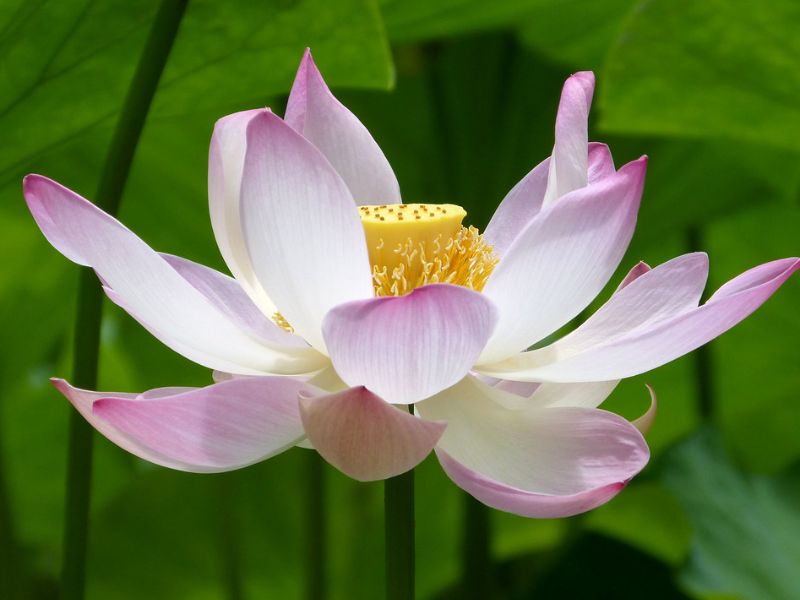
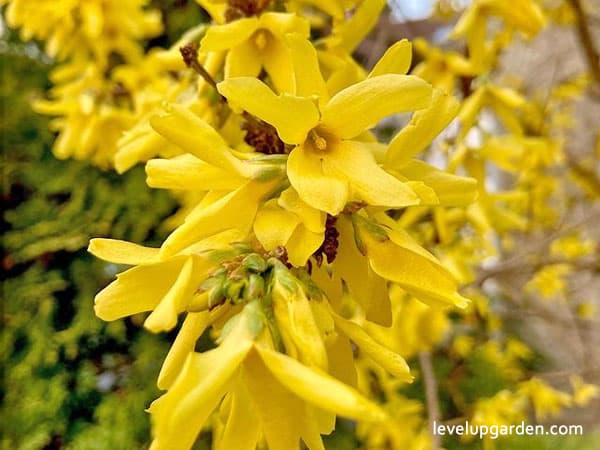






Leave a Reply